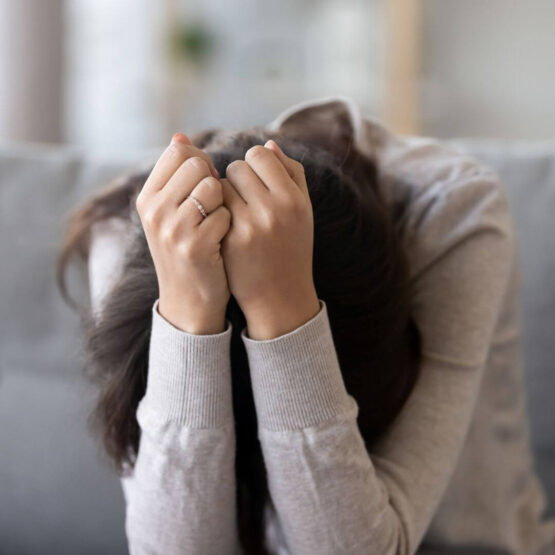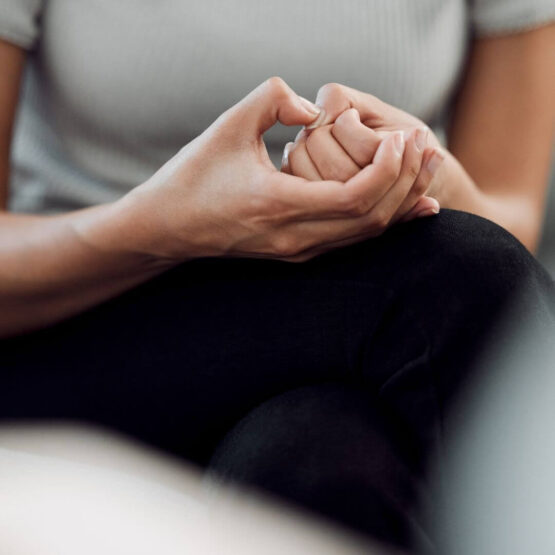Anxiety Disorders
Feelings of constant worry and stress that come from anxiety can be debilitating in daily life, relationships, or your overall happiness. Our services at PATH Integrated Healthcare work to help you fight back against the symptoms of anxiety. Your well-being is our top priority, and we will provide the highest standard of care in a compassionate and non-judgmental manner. Contact one of our clinics in Ohio, Louisiana, or Utah to start your path to optimized health today!

What is an Anxiety Disorder?
An anxiety disorder is a mental health condition that causes an individual to experience chronic and irrational worry, stress, fear, or dread. These disorders can be debilitating for sufferers as they often interfere with daily activities including job performance, school work, and relationships.
There is no one type of anxiety disorder; rather there are several types including:
- Generalized anxiety disorder (GAD)
- Obsessive compulsive disorder (OCD)
- Panic disorder
- Post-traumatic stress disorder (PTSD)
- Social anxiety disorder (SAD), also called social phobia
The causes of anxiety disorders aren’t always clear, but some can run in the family or even occur with other mental illnesses, such as depression or substance abuse. Sometimes trauma from a car accident, sexual assault, war experiences, or terrorism can make it worse. Anyone can experience anxiety, and it is a normal response to stress. Anxiety disorders tend to be more common in women than men.
What are the Symptoms of an Anxiety Disorder?
If you suffer from an anxiety disorder, you can experience a wide range of symptoms. Everyone is different, and may not necessarily have every symptom on this list. Some symptoms of these disorders can include:
- Constant worry around everyday events and interactions
- Always seeing the worst-case scenario
- A sudden sense of terror or impending doom
- Irrational fears
- Shortness of breath or dizziness
- Difficulty making decisions
- Concentration problems
- Agoraphobia (fear of situations that could cause panic)
- Avoiding leaving the house
- Feeling helpless
- Irritability
- Restlessness
- Fatigue
- Insomnia
- Muscle tension or chest pain
- Digestive problems

Occasional feelings of anxiousness are definitely normal, but when these feelings become persistent it means the person has developed an Anxiety Disorder, which stops them from living their lives normally due to constant worrying.
If you experience any of the above signs or symptoms, please contact a PATH clinic near you. Nothing in this article should be used for self-diagnosis or as a substitute for diagnosis.

What are Anxiety Signs?
An anxiety disorder is a mental health condition that causes an individual to experience chronic and irrational worry, stress, fear or dread. These disorders can be debilitating for sufferers as they often interfere with daily activities including job performance, school work and relationships. There are several types of anxiety disorders including generalized anxiety disorder (GAD), panic disorder (PD) , social phobia related-disorders such as specific/isolated phobias .
Occasional feelings of anxiousness are definitely normal but when these feelings become persistent it means the person has developed an Anxiety Disorder which stops them from living their lives normally due to constant worrying about things like what could go wrong in future etc.. There's no one type of Anxiety Disorders; rather there are several types of anxiety disorders, including:
- Generalized anxiety disorder (GAD)
- Obsessive compulsive disorder (OCD)
- Panic disorder
- Post-traumatic stress disorder (PTSD)
- Social anxiety disorder (SAD), also called social phobia
More Info About Anxiety Disorders
When to see a doctor
People with anxiety disorders need treatment to be able to lead normal and productive lives. Those who have had an anxiety disorder for many years may find it difficult to recognize that they need help, but may come in as a result of stress or family problems caused by the condition. Often those with anxiety disorders first come into medical attention when they seek help for insomnia or related sleep problems, which are common comorbid conditions.
Doctors may also treat a patient as a mental health specialist if other psychiatric symptoms such as depression or substance abuse co-exist with the anxiety disorder. In some cases, physical conditions involving pain medications and gastrointestinal or heart problems may trigger anxiety.
Anxiety disorders are also common in children and adolescents, who often display the same symptoms as adults but at a lower intensity. When left untreated or when treated improperly, these problems can persist or worsen into adulthood. Furthermore, anxiety disorder is associated with higher risk of suicide attempts and substance abuse among adolescents and young adults.
To make an appointment with a health professional to discuss anxiety disorder, contact PathIHC for a physician consultation.
Causes
The causes of anxiety disorders aren't always clear, but some seem to run in families and others occur with other mental illnesses such as depression or substance abuse. Sometimes "trauma" from a car accident, sexual assault, war experiences or terrorism can make it worse. Anxiety disorders are more common in women than men.
Diagnosis and tests
How PathIHC Doctors diagnose and test for Anxiety:
Doctors will diagnose anxiety disorder by asking patients about their fears and the situations in which they occur, how often, and under what circumstances. The doctor will ask whether the patient has specific phobias or generalized anxiety with constant worry over a period of months or years. Doctors also record the intensity of such fears using rating scales called "social phobia inventory" and "generalized anxiety disorder scale."
Doctors may also give questionnaires to the patient's parents, spouse or partner, and close friends to learn more about how the person with anxiety feels and behaves. These ratings are called "diagnostic criteria for social phobia in children," "social interaction anxiety in adolescents," and "social phobia scale."
Doctors will also use a computerized tomography (CT) or magnetic resonance imaging (MRI) scan to rule out medical problems that may be causing or contributing to anxiety symptoms. Psychological tests, including blood and urine tests, may also help diagnose the problem.
Doctors used to consider panic attacks as a component of many different anxiety disorders before they realized that the attacks were a separate condition in and of themselves. Now doctors generally distinguish between panic disorder and generalized anxiety disorder, which are not mutually exclusive.
Doctors will ask the patient to describe any events or situations that trigger panic attacks: running into an old friend, driving over high bridges, or being in crowds. Doctors may also ask patients how they feel during a panic attack: scared, helpless, and out-of-control. Until recently, researchers only reported the frequency and severity of such attacks; today, they also want to know about their cognitive symptoms or emotional experiences when having a panic attack.
Doctors will conduct extensive tests to rule out medical and other psychiatric conditions that can trigger panic attacks.
Doctors will also ask patients whether they have had similar symptoms, such as feelings of terror or being physically sick, in the past. Doctors call these "acute symptoms" to distinguish them from "incessant worrying" about when the attack started. Researchers are now studying the relationship between panic disorder and these pre-existing conditions, especially mood disorders such as depression or bipolar disorder.
A health professional may also request an MRI to check for abnormal brain structure associated with stress or a chemical imbalance in the brain around areas that regulate emotions, thinking, and behavior.
Psychological tests include:
* Beck Depression Inventory
* Beck Anxiety Inventory
* Minnesota Multiphasic Personality Inventory-2 (MMPI)
Physical exam includes: * Complete physical examination, including a head and eye exam to check for acne or other problems. * Blood tests are done to rule out neurological disorders such as epilepsy or multiple sclerosis. * Urine and blood tests are used to screen for depression, bipolar disorder, hyperthyroidism and other medical conditions that may cause anxiety. * Electrocardiogram (EKG) measures the heart's electrical activity.
Doctors use information from both patient interviews and psychological assessments in order to formulate a diagnosis and treatment plan. When making an initial diagnosis, it is important for the doctor to distinguish generalized anxiety disorder from other psychosomatic or stress-related illnesses and medical conditions. These may include panic attacks, hyperthyroidism, hypoglycemia, anemia, and migraine headaches.
Doctors will also consider substance abuse disorders which commonly co-exist with anxiety disorders.
When making the diagnosis, the doctor may include a list of all possible diagnoses including:
* Panic disorder with or without agoraphobia
* Atypical panic attack in children and adolescents
* Separation anxiety disorder
* Specific phobias or social phobia (social anxiety disorder) -- adults only
* Agoraphobia – adults only
* Obsessive compulsive disorder (OCD)
* Post-traumatic stress disorder (PTSD)
* Acute stress reaction and adjustment disorders
* Generalized anxiety disorder , which is diagnosed when the patient reports physical symptoms in addition to chronic worrying. * Substance abuse syndromes -- alcohol, heroin, Valium, marijuana, nicotine, and other drugs
* Psychotic disorders -- schizophrenia or manic-depression (bipolar disorder)
Although the DSM does not exclude patients who have experienced a panic attack from being diagnosed with other anxiety disorders, the APA advises against classifying this as having a separate medical condition. The fear of a panic attack that is caused by another medical condition, such as hyperthyroidism, is also considered to be a symptom of anxiety.
Anxiety disorders may also occur with or without other mental health problems: * Depression -- feeling depressed most days for more than two weeks and having anxious thoughts or feelings at the same time. * Bipolar disorder -- experiencing severe mood shifts that include periods of elated, manic behavior at the same time as having bouts of extreme anxiety. * Substance abuse -- abusing alcohol or drugs to avoid unpleasant feelings such as worry and anxiety.
Anxiety disorders can also co-exist with other mental health conditions: * Children with oppositional defiant disorder may be hyperactive and have trouble concentrating due to constant worry and anxiety. * Schizophrenia may manifest itself in hallucination or delusion, both of which can be associated with extreme fear and anxiety.
Family members are often the first to report symptoms because they know the individual well. When an individual is reluctant to seek help, family members may keep pushing until he or she gets proper treatment. Because there is a large degree of overlap between the symptoms of anxiety disorders and depression, feeling sad or hopeless may be the first sign that someone needs to seek help for an underlying problem.
Doctors treat people with anxiety disorders according to their exact diagnosis and symptoms: * People who have panic disorder may be prescribed medication or psychotherapy, often with the help of a psychiatrist. * Those who have social anxiety disorder may be referred to a psychologist or other mental health professional for cognitive-behavioral therapy which works to change thought patterns and behaviors that lead to fear in social situations. * Patients diagnosed with OCD are most commonly given drug treatment, although CBT may be effective. * PTSD is treated with psychotherapy, medication, or both.
Patients diagnosed with generalized anxiety disorder are most likely to benefit from cognitive-behavioral therapy in which they learn the connection between their reactions and anxiety symptoms and ways of coping with these feelings more effectively. Patients may also be given anti-anxiety medications to alleviate symptoms and help them learn to manage their condition.
As with other mental health disorders, treatment for anxiety is most effective when a patient sticks to the therapeutic regimen as directed by her doctor and receives support from friends and family members. Patients may also ask one or two close friends or relatives who have had similar problems if they would be willing to talk about their experiences.
Anxiety disorders, although common, are not a part of normal growing up and should be taken seriously by everyone who notices symptoms in themselves or others. Learning to manage feelings of worry and anxiety will make an individual more resilient when life presents challenging circumstances in the future.
Treatments
Treatment is usually done on an outpatient basis, but sometimes people need to stay in the hospital if there's a risk of self-harm or violence. Sometimes medicines and therapy are used together, either separately or at different times. types of medicine include antidepressants, especially selective serotonin reuptake inhibitors (SSRIs), and beta blockers.
Types of therapy include cognitive behavioral therapy that looks at ways to change the way a person thinks and reacts to things; interpersonal therapy that helps people deal with their relationship problems; or psychodynamic therapy, which treats anxiety as well as depression.
Prevention
How to prevent anxiety disorders?
Just facing your fears, one day at a time
Avoid alcohol and other mood altering chemicals. (Drugs, cigarettes)
Keep in mind that many people get anxiety disorder during pregnancy. Prenatal care is therefore recommended to see if any cases of panic disorder or postpartum depression are noticed before they become serious.
The main path to prevention is education of self, others and increasing awareness.
Education:
Doctors must be more aware of the problem and knowledge about it should be shared among various fields (mental health workers, psychologists, psychiatrists etc.) There should be a program for school children which will teach them to reduce stress and anxiety levels in areas like school, home and whatever other area which might cause anxiety.
Money:
There is no real cure for anxiety. Therefore reducing its frequency should be the goal of treatment. Increased funding would increase research into new treatments and therefore improve lives of people suffering from anxiety disorders.
Pain in childhood can lead to long term growth problems with anxiety later in life.
Hardware:
To avoid/reduce anxiety it would be useful to create systems that can identify and actually predict these problems before they occur. Software (systems) that could do this are already being made, like the cognitive modelling system QPR software . Anxiety disorders have an early onset in life therefore knowing the risk factors for anxiety could prevent problems later in life. Examples of such risk factors are childhood abuse, adverse life events and poor coping skills (Angermeyer & Matschinger 2001).
More research should focus on the general topic of biological predispositions to disorders in order to target those people who are likely to develop anxiety disorders because of their genetics, childhood environment and coping skills.
"Genetics: the first way that people get anxiety disorders is genetically. Some people are born with a predisposition to developing one or more anxiety disorder on account of the genes they inherited from either parent."
Dealing with anxiety in childhood can help prevent problems later in life. Education about emotions and problem thinking styles in children can help identify anxiety before it becomes serious.
Recently, studies have shown that Cognitive Behavioral Therapy (CBT) helps people decrease the severity of symptoms associated with anxiety disorders which is a great step forward towards treatment as this type of psychological therapy helps alter thought patterns to change behavior (Anxiety Disorders Association of America, 2012).
Although the percentage of people who are able to fully recover from anxiety in a completely natural way is very rare and only few cases have been recorded (and these were mostly non-western cultures not subject to the stresses of modern life) there are ways for people to try recover. Simple things such as keeping a journal, writing your feelings and thoughts down, exercising regularly, practicing deep breathing or meditating daily can help greatly. Also some positive thinking techniques can be used to stop negative thinking patterns from taking over the mind and self-confidence building exercises which can give you more control of your fears.
Support and Resources
https://www.healthline.com/health/anxiety-disorders
https://www.helpguide.org/mental/anxiety_disorders_adults.htm
https://www.psychologytoday.com/conditions/anxiety
http://www.mayoclinic.org/diseases-conditions/anxiety-disorders/basics/definition/con-20019221
https://www.nationalanxietycenter.org/
https://www.nimh.nih.gov/health/publications/anxiety-disorders/index.shtml
https://psychcentral.com
http://www.adaa.org/living-with-anxiety
http://kidshealth.org/en/teens/anxious-teenager.html
Symptoms
Signs and symptoms of anxiety disorder caused by a medical condition include:
Many people with generalized anxiety disorder have the patterns of thinking or behavior described below. However, everyone is different and will not necessarily have every symptom in this list.
People with panic disorder often report a sudden sense of terror or impending doom, and may believe they are in grave danger. Panic attacks usually occur unexpectedly during a calm state and may strike repeatedly and without warning. Some people develop irrational fears, like fear of driving on bridges or flying in airplanes. Others experience physical signs such as chest pain, shortness of breath, or dizziness. Many people with panic disorder may also suffer from agoraphobia and avoid public situations like shopping malls and restaurants.
GAD can be a chronic condition that impacts day-to-day life negatively. GAD symptoms are treatable! Getting help sooner rather than later is key to successfully managing your symptoms.
Mild anxiety disorder (generalized anxiety disorder) symptoms include:
Excessive, uncontrollable worry about several things or events that last at least six months can be a symptom of many different mental disorders and diseases. However, anxiety disorder (panic attacks) is the most common cause of severe worry. The person may feel helpless and out of control. People with anxiety disorders often worry about everyday things like family, health, school, work and money. Such worries are irrational and uncontrollable, which adds to the emotional toll on the sufferer.
In addition to the symptoms listed above, those with other anxiety disorders may experience persecutory fears that are present all day and are difficult to ignore. The person suffering from anxiety disorder may constantly be on guard not only for an attack (e.g., panic attack) but also for the next irrational concern or worry.
In addition, social anxiety can lead to general avoidance of social occasions, and even a complete inability to leave the house.
People suffering from social anxiety disorder also commonly experience symptoms such as muscle tension, increased heart rate (tachycardia), insomnia or other sleep problems, fatigue, feeling keyed-up or on edge most of the time (hyperarousal), spending excessive time checking themselves in mirrors or avoiding their reflection, blushing excessively, sweating excessively and nausea.
Psychological causes of anxiety disorder (panic attacks) include:
Psychological factors that sometimes play a role in the origin of panic attacks include:
As with any other medical condition only an appropriately licensed practitioner can determine whether your specific symptoms warrant recommendations for treatment with CBD-only products.
You should consult a medical doctor if:
If you experience any of the above signs or symptoms, please consult your physician. Nothing in this article is to be used for self-diagnosis or as a substitute for diagnosis, treatment, advice or health care management from a qualified healthcare provider.

How are Anxiety Disorders Treated?
Treatment is typically done on an outpatient basis, but sometimes people stay in the hospital if there’s a risk of self-harm or violence.
Sometimes medicines and therapy are used together, either separately or at different times. Types of medicine include antidepressants, especially selective serotonin reuptake inhibitors (SSRIs), and beta blockers. Not everyone with anxiety disorders requires medication, and counseling or therapy can also help control anxious emotions.
Types of therapy include cognitive behavioral therapy which looks at ways to change the way a person thinks and reacts to things; interpersonal therapy which helps people deal with their relationship problems; or psychodynamic therapy, which treats anxiety as well as depression.
The main goal of treatment for any anxiety disorder is to reduce feelings of worry and fear, while also developing healthy coping strategies that guide your response to triggers or stressors.
Contact a Clinic Today
At PATH Behavioral Healthcare, we are dedicated to assisting individuals in regaining control over their anxiety. Our team of medical professionals specializes in research-backed therapies, including cognitive-behavioral therapy and mindfulness-based approaches, to help you develop effective coping mechanisms and reduce anxiety symptoms. Moreover, our conveniently located clinics offer a safe and supportive environment where you can explore the root causes of your anxiety and learn valuable skills to manage it.
Don’t let anxiety hold you back from living a fulfilling life. Take the first step toward relief and contact us at PATH Behavioral Health today!
